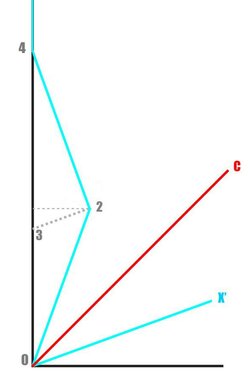
We can’t draw in 4 dimensions, so all 3 dimensions of ordinary space are reduced to the X-axis of the diagram. Motion to the left or right corresponds to movement in space. You’re sitting somewhere right now. You’re not moving. So there’s no motion left or right. But you ARE moving into the future at the rate of 1 second per second. The T axis represents motion in time. With every passing second, you move towards the top of the diagram. Any point in space or time can be shown on this diagram. Motion through space and time is, therefore, a line showing how you got there. This is called your “world line”.
Light travels 300,000 km/sec. A light ray is shown in red and marked C. The diagram has been scaled such that 300,000 km is 10 cm along the X axis and 1 second is 10 cm along the T axis. So the C line is halfway between X and T at 45 degrees. With me so far?
A ship leaves Earth and heads out into space. It travels along the cyan line T’. It is moving slower than light, so at all times a light ray which left Earth when it did is further from Earth than the ship is. Slower than light motion is called Time-like.
The pilot of the ship regards himself as “not moving” once the engines are turned off. He’s just sitting there and it’s the Earth that’s rushing away. That’s a perfectly valid viewpoint and it’s why his path is labeled T’. He’s going straight up HIS time axis.
But ALL observers measure the speed of light to be the same. Light always moves halfway between the T and X axes. If the pilot has a different T axis than you do, he must also have a different X axis. Only way he can measure light to have the same velocity as always. His space-axis is X’
Now, we’ll imagine an ansible has been invented. An ansible is faster-than-light radio. In fact, it’s instantaneous regardless of the distance between transmitter and receiver. Instantaneous is not really necessary. Any faster than light signaling will do, but it makes the diagrams easier to draw.
At 1, you broadcast an important message over the ansible. What does “instantaneous” mean? It means it takes no time to travel any distance in space. So the dashed gray line is horizontal. No motion in time at all. It is received by the space ship at 2.
The pilot sends a reply. How does it travel? Back to 1? No! That’s silly. Why should it retrace the path along your X axis. There’s nothing special about Earth’s motion. To be consistent, it has to go parallel to the ship’s X axis, the one we called X’. So it reaches Earth at 3. This is BEFORE you sent the original message at 1.
If the message sent at 1 was “planes hijacked to crash in New York”, then the police can take action at 3 to foil the plot. So the planes were never hijacked and you never sent the message at 1. We have a paradox!
You can change to any inertial frame you like at any time.

The ship left Earth at 0 and transmitted the message back at 2.
Then it used its motors to head back to Earth and landed there at 4.
Now it's back in the Earth-frame where it started and where the original message came from -- and where it was received at 3.
The ship can't get back in time to do anything about 911, but the superlight message could.
You can equally imagine you stay on Earth the entire time and your twin brother does the traveling (and returns younger than you are.)
tl;dr:
Space-axis (X) runs horizontally, time-axis runs vertically. Usually scaled so an arbitrary unit (like an inch) equals 300,000 km or 1 second. Therefore, light always travels along 45 degree lines.
Something (call it A) which isn't moving (with respect to you) runs straight up the T-axis at 1 (scaled) inch per second. If A IS moving, its vector is the same length, but tilted somewhat. Motion in space comes at the expense of motion in time.
A, of course, always considers himself stationary. His (tilted by your reckoning) path defines HIS T-axis. Call that T-prime since I can't write superscripts here. His X axis also deviates from yours. If you drew his T-prime to point clockwise of your T, then his X-prime is rotated counter-clockwise of your X. Only thus can the velocity of light remain invariant. It always bisects the angle between the X and T axes. Anybody's X and T axis.
That rotation in the "opposite" direction is why the geometry of Relativity is hyperbolic instead of a euclidean rotation. Time is subtracted, rather than added, in computing the Interval between events so all observers measure the same Interval even though they may differ in their separation into space and time.

